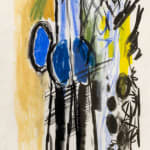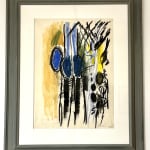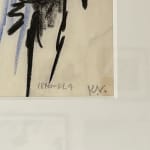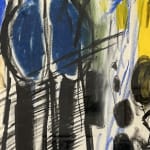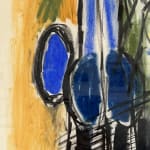Keith Vaughan
Abstracted figure, early 1960s
oil and pastel on paper
51 x 36.5 cm
Sold
Further images
This uncharacteristically large pastel dates from the early 1960's, not long after Vaughan returned from the USA. Hitherto he had used wax crayon to work with, but its greasy translucence...
This uncharacteristically large pastel dates from the early 1960's, not long after Vaughan returned from the USA. Hitherto he had used wax crayon to work with, but its greasy translucence had its drawbacks. In 1959 he discovered oil pastels while he was teaching at Iowa State University Art Department. Their rich density of colour and the immediate manner in which they could be applied instantly inspired him. Moreover they left no dusty residue nor did they smudge like traditional artist chalks . Oil pastel were virtually unknown in England at the time, and in a letter sent to his friend Prunella Clough Vaughan jokingly explained that they were 'waterproof, impervious to everything, can be rolled, stamped on, eaten!' (see Malcolm Yorke, Keith Vaughan, His Life and Work, London 1990, p. 189). He continued to use oil pastels for the next two decades.
Vaughan evolved a pictorial language that was rooted in observation but which was translated through abstract means. The fruit-like elements are reduced to contrasting rounded shapes. The economical use of colour assists in harmonizing these disparate elements into a coherent, tight composition.
(Note by Gerard Hastings 2016 to Lot 98 in Sotheby's sale on 28 September 2016 which was also in the Menier Gallery exhibition with No.644)
Vaughan evolved a pictorial language that was rooted in observation but which was translated through abstract means. The fruit-like elements are reduced to contrasting rounded shapes. The economical use of colour assists in harmonizing these disparate elements into a coherent, tight composition.
(Note by Gerard Hastings 2016 to Lot 98 in Sotheby's sale on 28 September 2016 which was also in the Menier Gallery exhibition with No.644)





